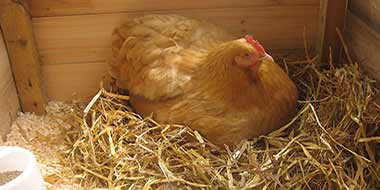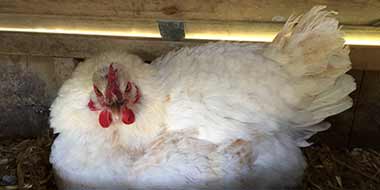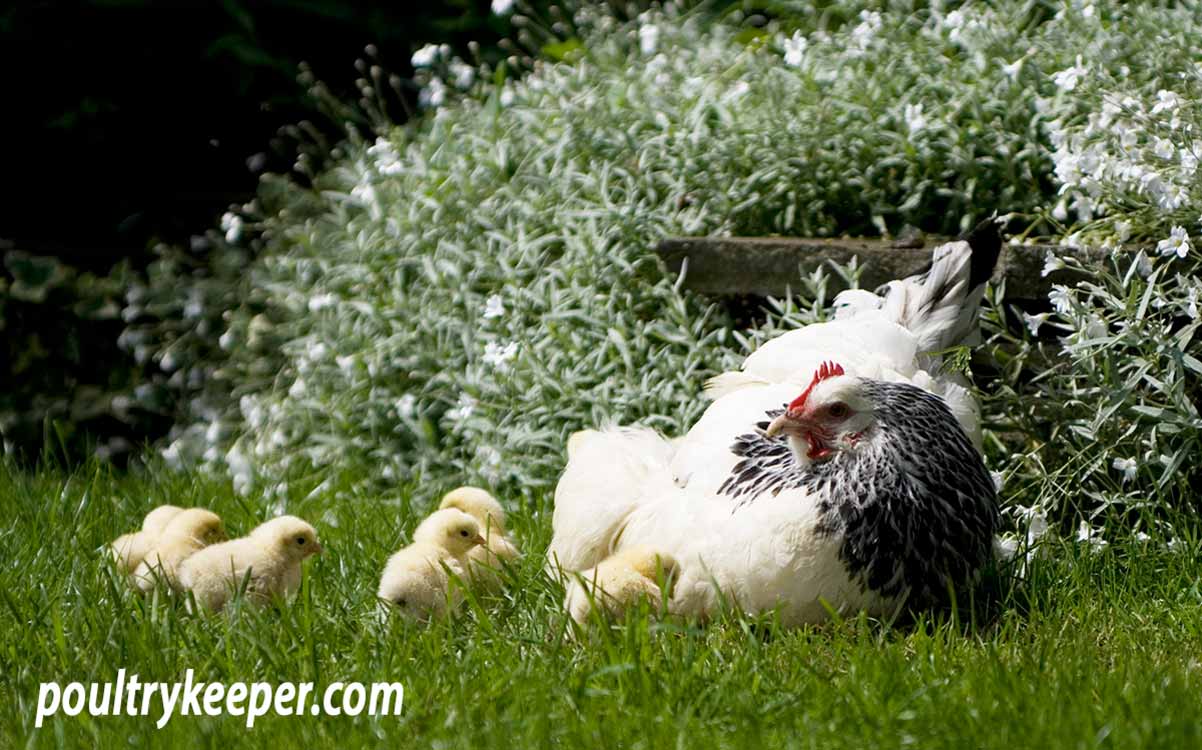
It is incredible seeing a broody hen raising chicks the way Mother Nature intended, and with just a little help, most are far better than us at caring for their chicks. This article on broody hen care is part of our Broody Hen Advice and helps you learn how to care for a broody hen raising chicks.
Broody Hen Advice:
- Hatching Eggs with a Broody Hen - What to do if you want to use a broody hen to hatch some fertile eggs.
- Broody Hen Care (this article) - How to care for a broody hen once she has her chicks.
- How to Stop a Broody Hen - We don't always want broodiness. Tips for breaking a broody hen.
A good broody hen will give her chicks the best start in life. She will teach them how to eat, drink and scratch for food, call them under her wings when danger approaches, and provide warmth at night.
Theoretically, she can raise her brood without any human help, but little chicks are very vulnerable to both predators and disease. Even adult hens may attack them. Although Mum will try to protect her family, she can’t be everywhere all the time, which is why we have to think about how to care for a broody hen with chicks.
Risks to young chicks
Predators and diseases
- Apart from all the usual chicken predators (foxes, badgers, stoats, mink etc.), chicks may also be taken by rats, cats, grey squirrels, magpies, birds of the crow family, birds of prey – in fact, just about any meat-eating creature.
- Young birds have no resistance to diseases carried by healthy adults who have built up immunity.
- The ground that adult chickens have used is likely to contain parasites and diseases.
- Coccidiosis can lead to many fatalities in young birds – it is often caused by lack of hygiene, overcrowding and stress.
Vaccinations
Most backyard chicken keepers do not vaccinate their chickens. However, it is worth considering if the breed is susceptible to a particular disease (i.e. Marek’s disease in Silkie Chickens) or if you are planning to sell the birds on.
Read the advice we have on vaccinating chickens and consult your vet before the chicks hatch, as many have to be given at a very early age to be effective. Although vaccines are generally sold in large quantities, most of them are relatively inexpensive.
Choosing a broody hen house
To give a broody hen raising chicks the best chance of success, she needs a secure broody hen house.
The coop should include sleeping-quarters and a run. The structure should be robust enough to keep out large predators, with no gaps to admit smaller ones.
Wire mesh must be of a small gauge to stop rats getting in – and tiny chicks from getting out!
The sleeping quarters should be easy for the smallest chicks to access safely – they won’t manage a steep ramp.
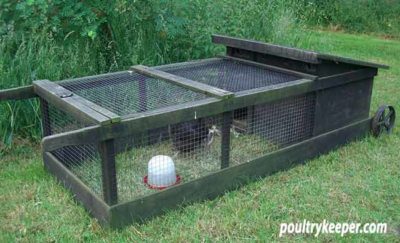
Ideally, the coop should have wheels or skids like this to move it to fresh ground regularly.
If a static coop is used, the run’s base can be lined with wire mesh stapled up the sides. This makes it very secure, but you should cover the mesh with a scratching material, such as hardwood chips, to protect the chicks’ legs and feet.
Once the chicks hatch, Mother Hen becomes very active, making up for the long weeks of inertia. The mother can easily tread on her chicks in a restricted space, so make sure the run is large enough. Some broody hen houses advertised as suitable for a broody hen, and chicks are barely big enough for a small guinea pig.
This plastic Eglu Go coop and run from Omlet is a popular choice because you can easily remove the floor and wash it.
Broody hen care: After hatching
Leaving the nest, food & drink
Once she’s decided hatching is complete, Mother Hen will lead her chicks out into the run. While they are busy exploring, clear out all the nesting material and replace it with fresh bedding.
If there are any eggs left in the nest, they are unlikely to be viable. Shake them gently (be careful they don’t burst), and if the insides sound liquid, they don’t contain any chicks. Alternatively, put the eggs in a bowl of warm water – if they bob about, there are live chicks inside.
However, once the broody has left the nest with her chicks, she won’t return to sitting duties. A chick that can’t escape the shell is likely to be weak, and if you decide to help it out, it will need extra care to have a chance of survival.
Occasionally things can go wrong; a hen can reject her chicks, start to peck them, or be so clumsy she will trample on them. If this happens, it’s always worth having a heat lamp available so that you can take over the raising of the chicks.
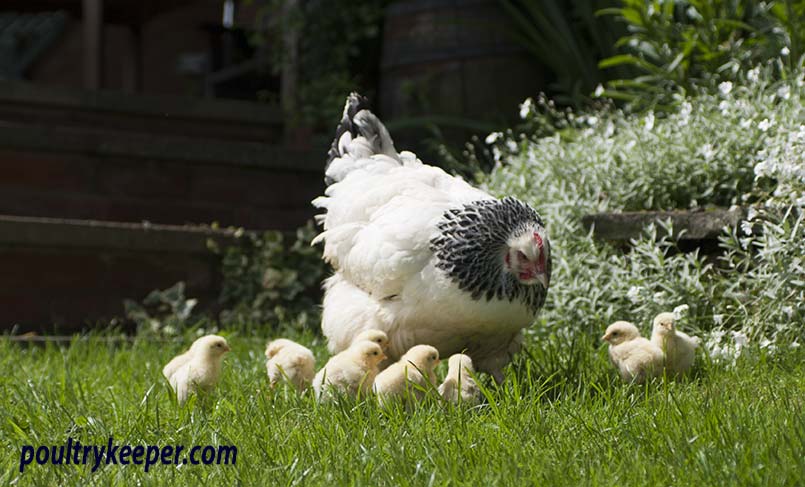
Food and drink for the chicks
Chicks can survive for over 24 hours after hatching on the contents of their yolk-sacs, but a small feeder and drinker can be placed within easy reach of the nest when hatching has begun.
It’s essential to choose a narrow-lipped drinker or one specially designed for chicks. The chicks quickly become very active and agile, climbing over and into everything. If they get wet, it can lead to chills, and they can drown even in shallow water.
Place the drinker in the run – not in the sleeping area, which can make the bedding damp. Standing it on a tile or a piece of wood helps keep the water clean and prevents the surrounding ground from getting wet.
The chicks will jump happily into their food given a chance, adding droppings and scratching feed everywhere. Mother Hen is likely to join in the fun too. A small feeder, preferably one with a partitioned trough, will save waste and mess.
It may even be necessary to suspend the feeder and drinker slightly above ground level – but make sure the chicks can easily reach them without having to stretch.
Feed good-quality chick crumbs. You can buy these either with or without an added coccidiostat medication (to guard against coccidiosis). Keep medicated chick feed away from other animals, especially waterfowl. If eaten by laying hens, there is usually an egg-withdrawal period (check with the manufacturer). The broody will share some of the chicks’ feed, so bear this in mind when she starts laying eggs again.
Provide some chick-sized flint grit to help the chicks’ digestive systems. Never feed soluble (oyster shell) grit to young birds, as it can cause developmental problems.
Be prepared to replenish the feeder and drinker frequently. Chicks need to eat little and often, but they get through a surprising amount. Fresh, clean water is vital, so regularly check that their drinker hasn’t become clogged with debris from Mum’s scratching and dust-bathing.
Feeding Mother Hen
Broody hen care is also about Mum. Mother Hen should have been fed a little mixed corn while sitting and will need to continue with this while she’s with the chicks. She’ll probably break some up for them to eat, too. Don’t let the chicks have access to feeds for laying hens.
Layers feed contains a lot of calcium that hens need for egg-laying. Extra calcium isn’t ideal for chickens that aren’t laying eggs, although the argument goes that we still use layers feeds over the winter and to cock birds.
If you are concerned, you could feed Mother Hen growers pellets. You will need these for your chicks, later on, anyway, so a bag won’t go to waste.
If the hen and chicks aren’t on grass, you could hang up a few fresh greens for them.
Other tips to keep mum & chicks safe
Ensure a broody hen raising chicks has a secure coop with shade during the hottest part of the day and shelter from prevailing weather.
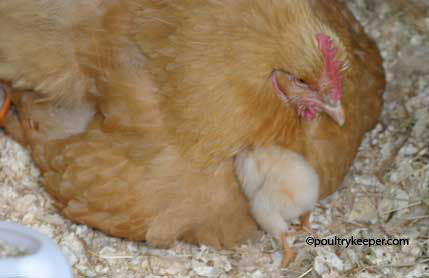 While the hen is usually able to keep the chicks warm at night, if the weather is cold, it may be necessary to put the broody coop inside an outbuilding and possibly provide a heat lamp (preferably a ceramic one that doesn’t produce light). Try to keep extra heat to a minimum, as it can slow down feather development.
While the hen is usually able to keep the chicks warm at night, if the weather is cold, it may be necessary to put the broody coop inside an outbuilding and possibly provide a heat lamp (preferably a ceramic one that doesn’t produce light). Try to keep extra heat to a minimum, as it can slow down feather development.
Watch for tunnels around the run – rats may try to dig their way in, or the chicks might start to dig their way out!
Recommended reading:
If you fancy incubating and hatching chicks, then look no further than "Hatching & Brooding Your Own Chicks" by Gail Damerow. This indispensable reference covers everything you will need to know about incubating, hatching and rearing chicks with a broody hen.
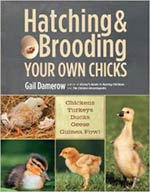
Always close the hen and chicks into their sleeping-quarters at night.
Warm, damp conditions are ideal for a disease to start developing. Prevention is better than cure:
- Scrub the broody coop between hatches with an incubator disinfectant.
- Ensure the nesting area of the coop stays dry – adequate ventilation helps avoid humidity – and change the bedding regularly.
- Don’t put the drinker inside, and try to avoid wet areas in the run.
- Regularly move the coop, or clean and disinfect the scratching material in the run.
- Keep the drinker and feeder clean and free from droppings.
And that’s how to care for a broody hen raising chicks!
Growing on the chicks
When the chicks are about six to eight weeks old, the hen usually starts showing signs of being ready to return to the flock. She may peck at the chicks and even begin laying again. The chicks should be fully feathered by now and no longer sleeping under Mum.
The hen can be allowed to rejoin the others (the pecking order may have changed in her absence, so be ready for some squabbles), while the youngsters should continue to live in the broody coop. Continue to monitor them throughout their development.
From around five weeks, you can gradually change the chicks over to a growers’ feed. Layers’ feeds are harmful to young birds who aren’t yet ready to produce eggs and should only be introduced later on at around 16 weeks, slightly later for heavy breeds.
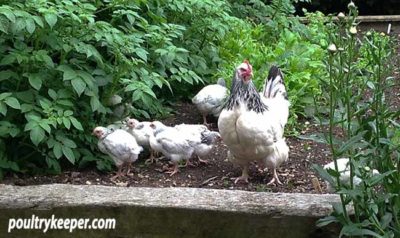
As the youngsters develop, it may be possible to identify the cockerels. Still, sexing chicks isn’t necessarily straightforward – it’s even been known for a cockerel to end up on an egg-laying farm!
Other useful articles & guides:
- Guide to Sexing Chicks - Separating the boys from the girls.
- How to Dispatch a Chicken - If you are going to dispatch the cockerels.
- How to Get Rid of Rats - Be on your guard with chicks and surplus feed around.
- How to Stop a Broody Hen - We don't always want broodiness. Tips for breaking a broody hen.
Pointed neck and shoulder hackles can be a good early indicator, as can larger combs, but sometimes the only way of knowing for sure is when the males begin to crow. Once you’ve picked out the cockerels, you might wish to separate them from their sisters.
There’s always likely to be a surplus of cockerels, and their eventual fate is something to be considered before putting eggs to hatch. It is difficult to find homes for unwanted males, and often the only answer is to dispatch them.
Be careful about offering them ‘free to a good home,’ as there are tales of domestic cockerels used for illegal cock-fighting practice.
Introduce the pullets to the rest of the flock when fully grown but haven’t yet started to lay (usually around 18 weeks). By this time, their mother will have forgotten them, and the procedure will be the same as for adding any new birds to an established flock.
They will have to sort out their places in the pecking order, and this is much better accomplished before they have the added stress of producing their first eggs.
Broody hen care is relatively straightforward, and rearing chicks with a broody hen has many advantages over raising chicks in a brooder, but it’s well worth spending a little time to get it right!

